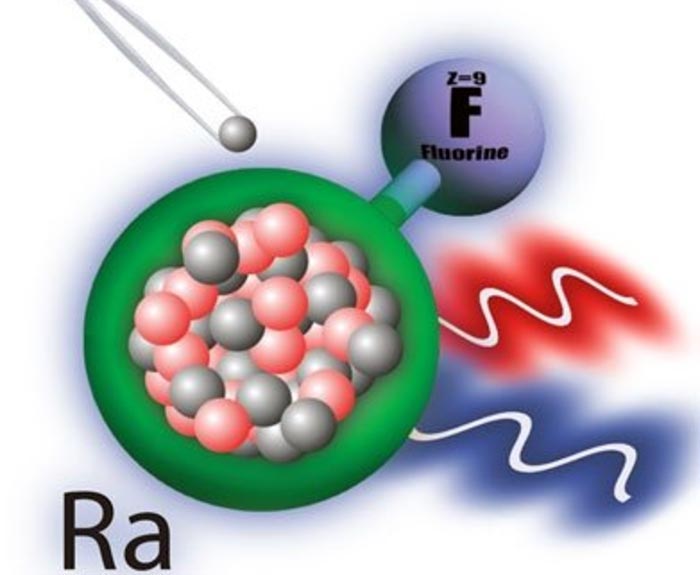Scientists measure radioactive molecules at the extremes of physics

Changing the number of neutrons (grey spheres) in the radium (Ra) nucleus changes the energy levels of the radium monofluoride (RaF) molecule. Small changes can be measured by using different lasers (blue and red wavy lines).
Image courtesy of Silviu-Marian Udrescu, Massachusetts Institute of Technology
Creating and studying radioactive molecules advances nuclear structure and fundamental symmetry studies.
The Science
An international team performed the world’s first measurement of how the size of the radium nucleus modifies the structure of molecules containing different radium isotopes. The research used a combination of lasers and ion traps at the Isotope mass Separator On-Line (ISOLDE) Radioactive Ion Beam Facility at CERN. The team studied the quantum structure of radium monofluoride (RaF) molecules. Quantum structure dictates the energy levels and how these levels change under different conditions. Scientists predict that RaF molecules are useful for studying the violation of certain fundamental symmetries found in nature. The team measured the changes in electronic energy levels when one of the radium nuclei was replaced with a different isotope. This demonstrates the extreme sensitivity of these molecules to the interaction of electrons and nuclei at short distances.
The Impact
The ability to precisely measure energy levels and modify the number of neutrons in the nuclei of the molecules opens new directions for research. The Big Bang should have created equal amounts of matter and antimatter. Violations of fundamental symmetries can explain why there is more matter than antimatter in our universe. Radioactive molecules containing isotopes of heavy elements like radium are ideal for studying the violation of these fundamental symmetries. Scientists also believe that their experimental developments could be applied to study other radioactive molecules that are created in supernovae and other stellar explosions. But scientists’ limited observational tools have prevented their identification in space. Thus, laboratory studies of radioactive molecules will help guide future astrophysical observations.
Summary
Radioactive molecules promise exciting new opportunities at the frontiers of fundamental physics and chemistry. However, they are very rare in nature, and some do not occur in nature at all. This means they must be created artificially at specialized facilities. Moreover, their lifetimes can be as short as a few days or a fraction of a second so studying them requires extremely sensitive experimental techniques. The Facility for Rare Isotope Beams (FRIB), a Department of Energy (DOE) user facility that starts operating in 2022, will provide unique access to molecules containing isotopes of the heaviest elements. Future developments of the current technique at this facility will offer a new platform for discoveries in fundamental physics. This will advance understanding of the fundamental symmetries of nature, as well as advance the understanding of the chemistry and nuclear structure of the heavy elements.
Funding
This work was supported by the Department of Energy, the ERC Consolidator Grant, the Office of Nuclear Physics, the MISTI Global Seed Funds, Deutsche Forschungsgemeinschaft (German Research Foundation), STFC, an Ernest Rutherford Grant, projects from FWOVlaanderen, the European Union Grant Agreement, the Russian Science Foundation, the BMBF, the National Key RD Program of China, and the National Natural Science Foundation of China.
Journal: Physical Review Letters
DOI: 10.1103/PhysRevLett.127.033001
Method of Research: Experimental study
Subject of Research: Not applicable
Article Title: Isotope Shifts of Radium Monofluoride Molecules
Article Publication Date: 14-Jul-2021
Media Contact
Michael Church
DOE/US Department of Energy
michael.church@science.doe.gov
Office: 2028416299
All latest news from the category: Physics and Astronomy
This area deals with the fundamental laws and building blocks of nature and how they interact, the properties and the behavior of matter, and research into space and time and their structures.
innovations-report provides in-depth reports and articles on subjects such as astrophysics, laser technologies, nuclear, quantum, particle and solid-state physics, nanotechnologies, planetary research and findings (Mars, Venus) and developments related to the Hubble Telescope.
Newest articles

You are What You Eat—Stanford Study Links Fiber to Anti-Cancer Gene Modulation
The Fiber Gap: A Growing Concern in American Diets Fiber is well known to be an important part of a healthy diet, yet less than 10% of Americans eat the minimum recommended…

Trust Your Gut—RNA-Protein Discovery for Better Immunity
HIRI researchers uncover control mechanisms of polysaccharide utilization in Bacteroides thetaiotaomicron. Researchers at the Helmholtz Institute for RNA-based Infection Research (HIRI) and the Julius-Maximilians-Universität (JMU) in Würzburg have identified a…

ASXL1 Mutation: The Hidden Trigger Behind Blood Cancers and Inflammation
Scientists show how a mutated gene harms red and white blood cells. LA JOLLA, CA—Scientists at La Jolla Institute for Immunology (LJI) have discovered how a mutated gene kicks off…



